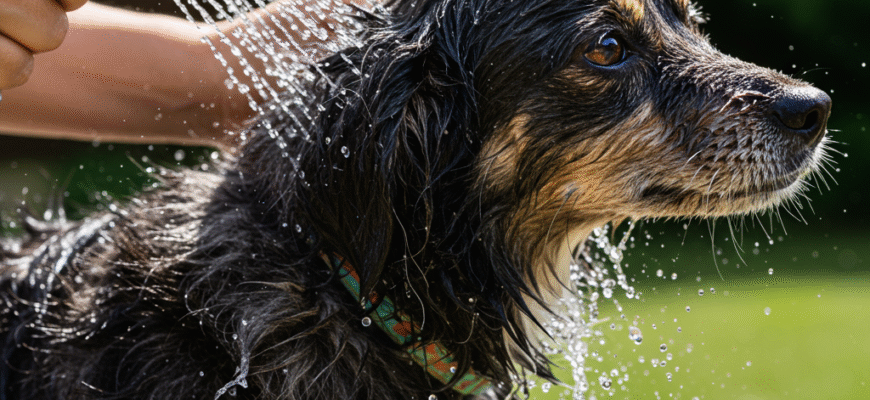Content
Why the Rinse is Non-Negotiable
Water itself isn’t the enemy, but what’s in the water can be. Both chlorinated pools and saltwater environments leave residues on your dog’s fur and skin that can cause problems if left unattended. Think of it like washing your own hair after a swim – you wouldn’t leave pool chemicals or sea salt lingering, and the same principle applies to your furry companion. Ignoring this simple step can lead to discomfort and potential skin issues down the line.Chlorine Culprits: More Than Just a Smell
Chlorine is fantastic for keeping pool water sanitary for humans, but it’s not so kind to canine coats and skin. Here’s why a thorough rinse is essential after pool time:- Stripping Natural Oils: A dog’s coat has natural oils that keep the fur healthy, water-resistant, and lustrous. Chlorine is designed to break down organic matter, and unfortunately, that includes these beneficial oils. When stripped away, the fur can become dry, brittle, and dull.
- Skin Irritation: Just like some humans find chlorine drying or irritating to their skin, dogs can experience the same. This can manifest as dryness, flakiness, redness, and persistent itching. Sensitive dogs are particularly prone to reactions.
- Potential Discoloration: While less common, prolonged exposure to chlorine without rinsing can sometimes lead to a slight lightening or discoloration of darker fur.
- Ingestion Risk: Dogs often groom themselves by licking. If their fur is coated in chlorinated water residue, they will inevitably ingest some of these chemicals. While small amounts might not cause immediate harm, repeated ingestion isn’t ideal for their digestive system.
Saltwater Setbacks: Drying and Discomfort
A romp in the ocean waves is exhilarating, but saltwater poses its own set of challenges for dog fur and skin:- Intense Drying Effect: Salt naturally draws moisture out. When saltwater dries on your dog’s skin and fur, it pulls moisture away, leading to dehydration of the skin and coat. This results in dry, itchy skin and brittle fur, similar to the effects of chlorine.
- Abrasive Crystals: As saltwater evaporates, it leaves behind tiny salt crystals. These microscopic crystals can be quite abrasive against the skin, especially in areas with friction, like under the collar, harness, or in their ‘armpits’. This constant rubbing can cause irritation and chafing.
- Aggravating Licking: The itchy feeling from dried salt can encourage excessive licking. This constant licking, combined with the abrasive salt crystals, can quickly lead to inflamed skin, sores, or painful hot spots (acute moist dermatitis).
- Matting Magnet: Salt residue can make fur slightly sticky or stiff, making it more prone to tangling and matting, especially in longer-coated breeds.
Important Skin Alert: Leaving chlorine or salt residue on your dog’s fur isn’t just uncomfortable; it can lead to significant skin irritation. This includes dryness, intense itching, redness, and potentially painful hot spots if your dog licks or scratches excessively at the affected areas. Always prioritize a thorough fresh water rinse immediately after swimming to protect their delicate skin health.
The Essential Post-Swim Rinsing Routine
Okay, so rinsing is important. But how do you do it effectively? It’s simpler than you might think, but thoroughness is key. Make it a standard part of your post-swim ritual.Step 1: Act Promptly
Don’t wait until you get home hours later if possible. The sooner you rinse the chlorine or salt off, the less time it has to dry and start causing irritation or strip oils. If you’re at a beach or pool with access to a fresh water hose or shower, use it right away. Even bringing along a few large jugs of fresh water specifically for a quick rinse is better than nothing.Step 2: Use Fresh, Lukewarm Water
The magic ingredient is simply clean, fresh water. Avoid using hot water, as this can further dry out the skin and be uncomfortable for your dog. Cool or lukewarm water is perfect. Ensure the water source is clean – rinsing with dirty pond water won’t help!Step 3: Be Thorough – Really Thorough!
This is where many owners fall short. A quick splash isn’t enough. You need to systematically rinse your dog’s entire body. Pay special attention to:- Underbelly and Groin: These areas often stay wet longer and are prone to irritation.
- Armpits: Friction here makes residue particularly problematic.
- Paws: Get right in between the toes and pads where salt crystals or chemicals can hide.
- Around the Collar/Harness Area: Residue can get trapped under collars or harnesses. It’s often best to remove these before rinsing.
- Ears (Exterior): Gently rinse around, but not directly into, the ear canal. More on ear drying later.
Step 4: Use Gentle Pressure
While you need to be thorough, you don’t need to blast your dog with a high-pressure jet. Use a gentle shower setting or a hose on a low-to-medium flow. High pressure can be frightening for some dogs and might even drive sand or debris deeper into the coat rather than washing it away. Work with the direction of fur growth.Step 5: Shampoo? Usually Not Necessary
For a standard post-swim rinse after exposure to relatively clean pool or ocean water, a thorough fresh water rinse is typically sufficient. You don’t need to give your dog a full bath with shampoo every single time they swim. Over-shampooing can also strip natural oils. However, consider using a mild, dog-specific shampoo if:- The water was particularly murky or dirty (like a lake or pond).
- Your dog has rolled in sand or mud extensively after swimming.
- Your dog has known skin sensitivities that benefit from a specific soothing shampoo after potential irritation.
- You notice a strong chlorine smell lingering even after a thorough rinse.









